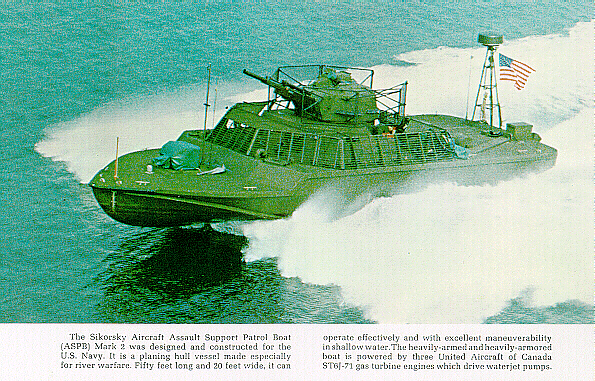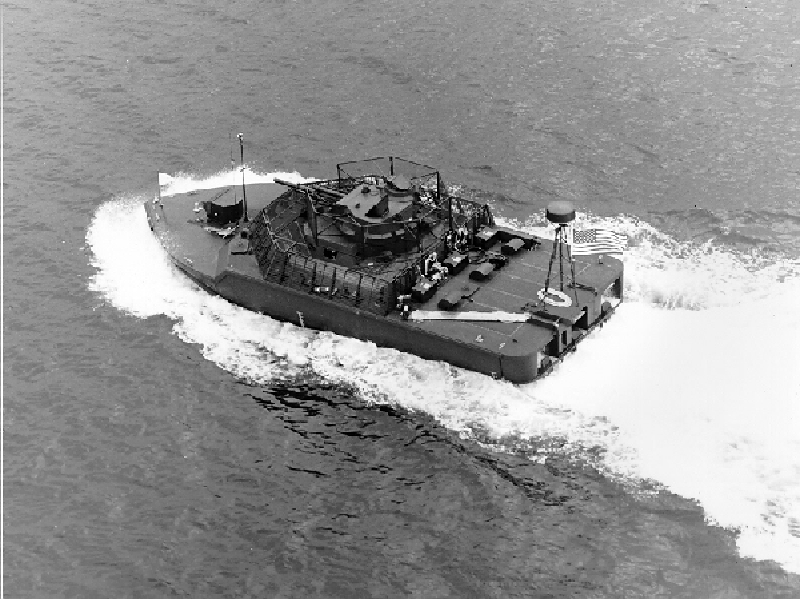Sikorsky Product History
Sikorsky Assault Support Patrol Boat
Background
In 1967 Sikorsky Aircraft decided to diversify. In the next four years the TurboTrain was designed, the S-67 Blackhawk armed helicopter and the Assault Support Patrol Boat “ASPB” warship designed for riverine warfare.
Riverine Warfare
This type of warfare involves the use of ground troops and naval craft operating in close coordination; in swamps, marshes and river deltas. In this environment normal ground transportation, weaponry and typical naval vessels usage is very limited and generally rendered ineffective. This is a battle ground of light troops and small boats, whose attributes were speed and the ability to operate in shallow water within confined areas.
In Vietnam from 1950 to 1975 the fighting centered in the Mekong Delta, about one third of Vietnam. The communist forces controlled much of the land and for the most part, the water ways. The French and the South Vietnam Government, with American advisors, tried to regain control.
The battle field, which is one of the most fertile on earth was flooded in the monsoon season and produces at least two thirds of the country’s food supply. This land consisted of water channels, canals and creeks which crisscrossed the delta creating thousands of islands.
The war proved to be a “mosquito and bludgeon war”, the Viet Cong being the mosquito and the U. S. Navy the bludgeon. The responsibility of the riverine force was to patrol the delta with gunboats and if the enemy was located, troops were landed from the gunboat or waiting troop transport boats. The troops would engage and attack the Viet Cong while the gunboats provided support fire. What was lacking was suitable artillery fire, the largest weapon fitted to the gunboats was a 40 Millimeter cannon or 80 millimeter mortar.
The ASPB Gunboat
Sikorsky won a U. S. Navy contract to build a prototype ASPB (Assault Support Patrol Boat) boat. Sikorsky designed the ASPB for its environment, the ASPB warship was in reality a floating tank, and much more. It was approximately 50 feet long and 20 feet wide and powered by three Pratt & Whitney PT-6 turbine engines connected to three water-jet pumps. On smooth river water the ASPB could reach speeds of 50 miles per hour and maneuver in only water 4 feet deep. Also this type of drive system allowed the ASPB to turn rapidly, maneuverability was critical because of limited space within the delta rivers.
It had a central turret with a 105 millimeter howitzer and two 20 millimeter automatic cannons. The howitzer was the most command artillery piece in the Army’s inventory and parts and ammunition was readily available. The howitzer is capable of firing directly at an enemy or indirectly at high angles over obstacles in support of our ground troops. The 20 millimeter cannons were rapid fire machine guns for short range attacks and also they were used to defend the ASPB. Both weapons allowed the ASPB to lay down fire outside the range of the Viet Cong’s 300 meter range of their rocket propelled grenades. Also a small machine gun was installed in the bow of the ASPB for quick reaction defense in case of an ambush.
A unique armor system was designed for the ASPB called “bar armor”. It is a light steel bar grill mounted 3 to 4 feet away from the hull and superstructure. This armor defeated the Viet Cong’s rocket grenade by exploding the grenades armor piercing warhead against the “bars” before it reached the ASPB. The use of this armor allowed the ASPB to be designed with a lighter armored hull reducing the ASPB’s overall weight.
The ASPB was delivered to the U. S. Navy at the end of 1969, but never saw operational use because the war ended. However the ASPB was used by the Special Forces to train for riverine warfare until 1980 when it was taken out of service.


